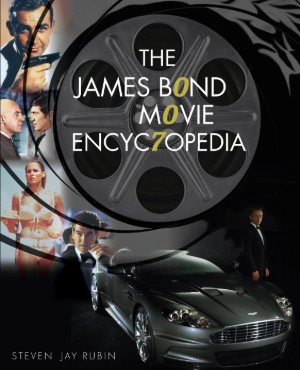The Special Executive for Counter-intelligence, Terrorism, Revenge, and Extortion, a huge international criminal organization headed by Ernst Stavro Blofeld, and James Bond’s principal adversaries in a dozen Bond films and counting. SPECTRE has a long screen history dating back to 1958, when Ian Fleming worked with producer Kevin McClory to bring his James Bond character to film. Rather than adapt any of Fleming’s existing Bond novels, McClory suggested creating a new story, an international caper that could use many different locations, not unlike his then recent experience on Mike Todd’s epic film Around the World in 80 Days. In the early drafts of this story—conceived by McClory, Fleming, and screenwriter Jack Whittingham—the principal villains were the Mafia. Eventually the mob adversary was discarded and Fleming conceived of SPECTRE (which at first stood for Special Executive for Terrorism, Revolution, and Espionage), an immensely powerful, privately owned organization manned by former members of SMERSH (Soviet counterintelligence), the Gestapo, the Mafia, and the Black Tong of Peking. The idea struck a chord with the collaborators and became Bond’s adversary in their story, the initial title of which was Longitude 78 West, after the coordinates where SPECTRE hides two A-bombs it has hijacked from NATO.
When McClory could not convince a major studio to finance the project, Fleming went ahead and used SPECTRE and other story elements in a novel titled Thunderball—the code name of Bond’s mission to find the missing bombs. Claiming infringement of their collaboration, McClory and Whittingham sued Fleming in the British courts, and after a grueling three-year battle, they won. As a result, McClory and Whittingham were given the screen rights to Thunderball and co-credit on future editions of the popular book.
Meanwhile, producers Albert R. “Cubby” Broccoli and Harry Saltzman at Eon Productions had already featured SPECTRE as the organization behind the villains in their first two Bond films, Dr. No (1962) and From Russia with Love (1963), even though the organization was not featured in either of those original Fleming novels. (Originally, Dr. No worked for the Russians, as did Rosa Klebb and Donald Grant in From Russia with Love.) Considering the state of the Cold War in the early 1960s, the producers wisely decided to avoid the cliché of casting the Soviets as their villains. The fictional, apolitical SPECTRE was the perfect umbrella organization for the types of fantastic schemes pulled off by the Eon series’ villains.
As for McClory, with the film rights to Thunderball but no ability to mount a 007 film on his own, he eventually made a deal with Broccoli and Saltzman to produce Thunderball as part of their already thriving series. SPECTRE played a key role in Thunderball (1965) just as it had in the book, and Blofeld and SPECTRE returned in You Only Live Twice (1967), On Her Majesty’s Secret Service (1969), and Diamonds Are Forever (1971).
But a new conflict soon arose regarding the SPECTRE concept. Under the agreement with Eon, McClory had agreed to wait ten years before producing another Thunderball adaptation. Promptly in 1975, he resurfaced with plans to bring a new project to the screen called James Bond of the Secret Service, a.k.a. Warhead. Burned once before by the release of a rival Bond movie—Charles K. Feldman’s Casino Royale spoof in 1967—Cubby Broccoli was determined to stop McClory. A running battle began between the two producers, culminating in a number of lawsuits that stalled the McClory project on the one hand, and challenged Broccoli’s use of the SPECTRE material on the other.
Early drafts of Eon’s 1977 Bond entry The Spy Who Loved Me contained references to SPECTRE, which had now been updated to include members of the Baader-Meinhof Gang, the Japanese Red Army, and other modern terrorist organizations. Faced with a McClory suit about the unauthorized use of SPECTRE, Broccoli had his screenwriters remove these references, and villain Karl Stromberg (Curt Jurgens) became just another billionaire megalomaniac. Even soldiers in Stromberg’s private army were given red uniforms to distinguish them from typical black-suited SPECTRE henchmen. Broccoli eventually introduced a Blofeld lookalike for Bond to kill off at the beginning of For Your Eyes Only (1981), but the film was careful not to actually identify the character as Blofeld.
But SPECTRE did make an appearance in Kevin McClory’s renegade Thunderball adaptation, which producer Jack Schwartzman helped muscle into theaters over Broccoli’s objections in 1983. In Never Say Never Again Max von Sydow portrays Ernst Stavro Blofeld. His SPECTRE, still based in Paris, is now heavily involved in the arms and terrorism business, with extensive operations in the Middle East and Central America. To provoke insurgency and revolution, armaments and missiles are indiscriminately supplied to rebels and government forces—a typical SPECTRE tactic. But with this movie a one-off proposition, and the Eon films steering clear of the Thunderball material for legal reasons, that was the last time SPECTRE was seen on screen until well after the turn of the millennium.
Then, on November 15, 2013, MGM and the McClory estate announced a deal: all rights to Blofeld and SPECTRE had been acquired by MGM and Danjaq LLC, Eon Productions’ parent company. As a result, SPECTRE retroactively emerged as the principal nemesis of the Daniel Craig Bond movies. In 2015’s Spectre we learn that the organization was the shadowy force behind the villains of the previous films: Casino Royale’s Le Chiffre (Mads Mikkelsen), Quantum of Solace’s Dominic Greene (Mathieu Amalric), and Skyfall’s Raoul Silva (Javier Bardem). Spectre also reintroduces Blofeld himself, now played by Christoph Waltz and suddenly revealed to be James Bond’s foster brother. SPECTRE and Blofeld return in No Time to Die.

